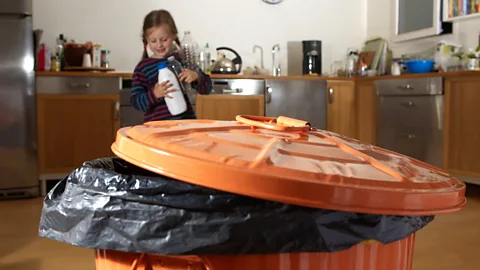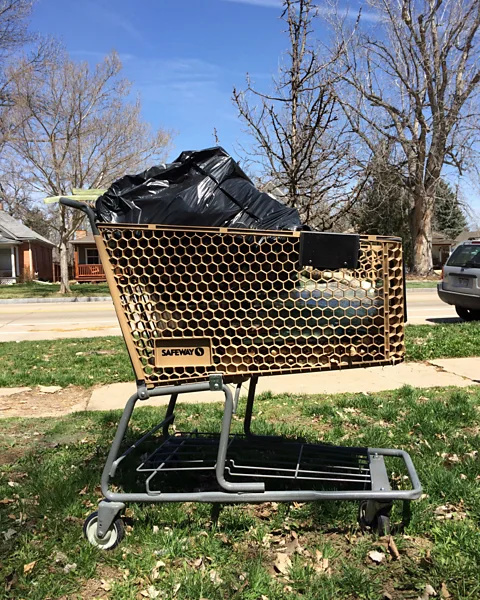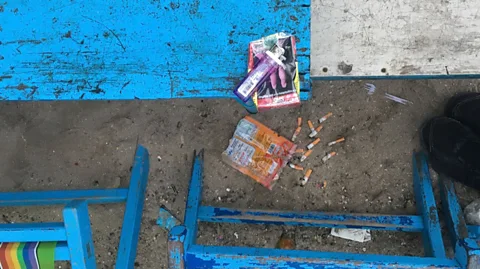Garbology: How to spot patterns in people's waste
 Getty Images
Getty ImagesWhether it's indulgent food choices, sexual habits or North Korean secrets, the stuff that people throw away can reveal all, says Chris Baraniuk.
Dangling over the pool of sewage, at the end of a mercifully long handle, was a small fishing net. The Baltimore city worker wielding this instrument angled it gently into the fetid muck and scooped from the surface a sought-after prize – one used condom.
In the late 1980s, around the height of the Aids epidemic in the US, a team of health experts wanted to monitor whether people were following advice to practise safe sex. So they began counting the flushed condoms, which turned up at wastewater treatment plants. By early 1988, workers were finding between 200 and 400 every day.
"It's certainly not a very pleasant job, but it is important," one Aids surveillance supervisor from the local health department told the Associated Press at the time.
Officials in other countries have since used the same method. In 2006, sewage workers in Eswatini (previously known as Swaziland) estimated that condom use had increased 50%. They noted how the prophylactics were just the right size to get stuck in the second set of filters at water treatment facilities, thus allowing them to be counted. A boom in condom use was also noted in Zambia in 2015 when thousands of them clogged sewers in the capital.
One person's trash, even in its most nauseating forms, is another person's data. Garbage, be it flushed, discarded or recycled, carries a wealth of information about people's decisions and behaviours, which you often can't get anywhere else. Those who dare to sift through this human detritus are known as "garbologists", and their efforts have helped us understand everything from people's health and food choices to the workings of secretive political regimes.
There's something refreshingly straightforward about studying rubbish, says anthropologist Thomas Hylland Eriksen at the University of Oslo. "It gives you a very direct and a very privileged window into people's actual way of life," he says.
You may also like:
The term "garbology" was coined by a US writer and activist in the early 1970s, but it was the anthropologist William Rathje who took garbology to more scientific territory, a few years later. In a now-famous study called The Tucson Garbage Project, Rathje and his colleagues scoured landfills, excavating and categorising great piles of waste dumped by residents of Tucson, Arizona. He also compared the contents of consenting individuals' rubbish bins with what they said about their eating and drinking habits in questionnaires – only to find that people clearly downplayed the amount of junk food and alcohol that they consumed.
 Getty Images
Getty ImagesIn the following decades, garbology would also help political researchers and historians when they found official sources of information absent or difficult to access.
In the 1990s and early 2000s, a handful of researchers realised that they could unlock the history of China's Cultural Revolution by sourcing piles of waste paper thrown away by local households or officials.
Jeremy Brown, a historian at Simon Fraser University in Canada, was one of those researchers. Frustrated by the limited access granted to him at official archives, he would go to flea markets in Tianjin every weekend and hunt for reams of discarded documents bundled together for a quick sale.
Once the peddlers at the flea markets knew the sort of thing he was looking for, they would search for it in piles of rubbish. Thanks to the efforts of these entrepreneurs, Brown was able to snap up papers that showed how deportations of people from urban to rural areas had been orchestrated by local governments, for example.
"That was a big finding that would not have been possible without the flea markets, without these things that were on their way to being destroyed," he says.
More recently, garbology has aided others seeking to peer into an even more closed and enigmatic country: North Korea. In February, The Guardian reported on research in which a professor in South Korea has collected more than 1,400 North Korean product wrappers that had washed up along the South Korean coast.
Intriguingly, the more recent sweet wrappers were colourful and sophisticated, hinting at subtle cultural changes in a country where daily life is heavily restricted.
 Getty Images
Getty ImagesMeanwhile, in Poland, archaeologist Grzegorz Kiarszys from Szczecin University has scoured waste dotted around a handful of abandoned Soviet tactical nuclear weapons bases, with the hope of gaining insights into the secretive activities there.
He says that remote sensing techniques, such as aerial photography and laser scanning, as well as declassified satellite imagery from the 1960s and 1970s helped him to study some of these sites. But by searching through rubbish that he found at these former bases, he has been able to build up a picture of what life was like for the people who once lived there.
The debris is highly domestic. Razors, lipsticks, mascaras and used bags of powdered milk abound, as well as children's toys, since soldiers' families were stationed at these places. Notably, he has found relatively expensive toys such as Lego bricks, which were not available to the general public during the communist era in Poland.
"It seems that Soviet officers had some access to foreign currency," he says.
 Grzegorz Kiarszys
Grzegorz KiarszysWaste, though soon forgotten by those who produce it, inevitably acts as a somewhat grubby expression of society. Leila Papoli-Yazdi, an archaeologist at Linnaeus University in Sweden, has used garbology to better understand the demographics of people living in the Iranian capital, Tehran.
By searching through household waste, which is dumped in bins on street corners in the city, she was able to detect clear differences between districts. There was ample evidence of drug abuse in lower-income quarters, for instance. And in one area, she and her team were surprised to find an unusual amount of paper in the waste bags they examined. It turned out that the local population had changed in recent years and now represented a group of unfortunate middle-class individuals, who were more likely to be readers of newspapers than lower-class inhabitants.
"The new tenants, mostly jobless educated people, included teachers, unemployed workers, [and] bankrupt businessmen [who] had lost the possibility to rent a place in more expensive districts due to the economic crisis of the last decade," wrote Papoli-Yazdi in a 2021 paper describing her work.
Commercial waste
In parallel to these academic studies, garbology has become an attractive tool for businesses.
In the 1970s, a brand of yoghurts called Ski were popular in the UK, but faced competition from rival brands Prize and Cool Country. Stephen Logue, a businessman who was once senior product manager for Ski, recalls how the company engaged a firm called Audits of Great Britain (AGB), which was running a "dustbin audit" across thousands of households.
People were paid to place packaging from various domestic products, including yoghurts, into a separate bin when they threw them away. Analysts regularly collected and tallied the contents of these bins to see which brands were performing better than others.
"It was all very above board," says Logue. The fact that people were aware that their rubbish was to be examined might have made them selective about what they put in the separate bin, he notes – but perhaps the effect of this died down over a long period. In any case, Logue got the data he wanted. "We could see that Ski was doing well," he recalls.
 Getty Images
Getty ImagesTracking what people buy has become much easier with the rise of barcodes and loyalty cards, which allow retailers to record every product sold. Online shopping offers even more granular data. But for those in marketing, there is an appealing grittiness to garbology all the same. Datha Damron-Martinez, retired associate professor of marketing at Truman State University in Missouri, says that, working as a consultant, she used to occasionally propose to firms that they use garbology as a form of observational research if they wanted to know more about consumption trends within a target population.
She and her colleague Katherine Jackson also used garbology as a teaching aid, in which students would bring in waste bins from their rooms. Other students, who didn't know to whom the rubbish belonged, would then pick through it and try to infer what sort of person had thrown those particular things away. Damron-Martinez says she was constantly surprised at how revealing the process could be. She recalls a case in which one subject's girlfriend had added her own rubbish to the bin without his knowledge.
"The students pulled it out and said, 'This has to be garbage from two people, here's why'," recalls Damron-Martinez.
But rifling through rubbish in an attempt to gain a competitive edge in the marketplace is not always a good look. In 2001, Proctor & Gamble (P&G) halted a "dumpster-diving" project that had sought to gather information about rival Unilever's hair-care business. Although P&G insisted it had broken no laws, the firm admitted the activity was "outside our strict competitive business information gathering policy".
 Jeremiah Mock
Jeremiah MockThere can be something unsettling about garbology, besides the spectre of espionage, though. And it's that it draws attention to the sheer volume of waste that's out there waiting to be dug up or simply picked over and analysed. Anthropologist Eriksen argues that the gargantuan piles of waste that now litter the planet are symptoms of what he calls "overheated modernity".
"There has been an acceleration of everything," he explains – from trade to waste. "There is something about the way in which global civilisation is being managed – or not managed – which shows us that there are many things that are out of control."
Notably, more remote and traditional communities sometimes produce significantly less waste. A 2003 study by Ann Marie Wolf, executive director at the Sonora Environmental Research Institute in Tucson, Arizona, and her colleagues analysed the rubbish thrown away by the Native American Tohono O’odham people. The researchers found that it amounted to less than a third of the solid waste, per person per day, than the US average. It also contained far less hazardous material than is common elsewhere in the country.
Someone who has reckoned with the ubiquity, and toxicity, of waste in our midst is health anthropologist Jeremiah Mock at the University of California San Francisco. He didn't even need to dig through someone's bin. He simply walked around car parks outside schools, collecting cigarette butts and vaping pods.
"To my surprise, I started very quickly finding Juul pods and Juul caps like all over the place," he says, referring to a brand of e-cigarette products. A 2019 study described how these peripherals accounted for about a fifth of the smoking-related litter that he found at 12 Californian high schools.
Mock remembers bringing bags of the waste he had collected to hearings so that local legislators could see it for themselves. As they passed the bags around, the odour of the vape fluids emanated from inside, he recalls.
"It was literally tangible to them, they looked at this stuff and they were horrified by it," says Mock. In 2019, many local jurisdictions in California banned Juul and other vaping products from sale. Mock's research continues and he says he remains concerned about the volume of smoking-related litter that he finds, especially given how harmful it can be. Cigarette butts can contain toxic chemicals including formaldehyde, arsenic and lead.
"When you look at the thousands, the tens of thousands, of waste items that we've found, it becomes really shocking," he says. "Because they're just everywhere."
 Getty Images
Getty ImagesPeople even fill virtual spaces with rubbish now. Jared Hansen, a journalism and communications PhD candidate at the University of Oregon, has spent hours wandering around the online game Animal Crossing, looking for things people have thrown away – in cyberspace. Thanks to a feature that lets you explore virtual towns used by other players without actually interfering with their game, Hansen was able to document examples of in-game items that people had apparently lost or discarded.
"Scattered among the trees was evidence of a previous quest to capture a bee," he wrote in a paper published last year, referring to the diminutive digital beehives, among other items, that he discovered littering an orchard.
In general, his findings reflected the lengthy efforts people go to in Animal Crossing to acquire digital objects and progress in the game. The litter, being scarce and associated with specific tasks, hints at the thrifty behaviour of an industrious society, he argues, adding that he now looks at discarded virtual items, also known as loot, in other online multiplayer games in a new way.
"I pay attention to what's the loot no-one wants," he says. "Why is it being left around?"
Paying attention is what really matters when it comes to waste these days because hardly anyone gives it a second thought. Garbology fascinates with what it can tell you about a person or a society, yes, but on a more fundamental level, it is one of the few ways we have of grappling with the sheer volume and complexity of the mountainous waste piles we are constructing.
The garbologists are among the few who bother to delve into these discarded, forgotten hoards. It is they who take the time to notice just how much we have all thrown away and ask: "What does it all mean?"
--
